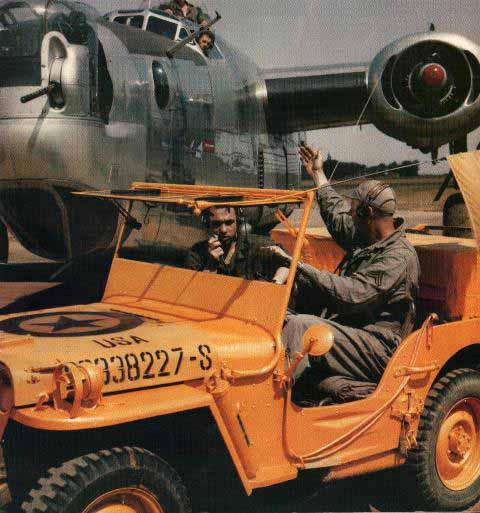 |
 |

Follow Me jeeps were jeeps that were used at airfields
to help control ground traffic of airplanes at an air base.
Follow Me jeeps used close to the front remained the normal olive drab
paint color, but at bases farther to the rear, the jeeps became brightly
colored.
The jeep in the picture is a solid bright yellow in color. The 3rd
color scheme, after OD and solid yellow, was a yellow and black checkerboard
pattern.
The reason for the bright colors was so the jeep would be seen by the
pilots of the aircraft. The flight line was always a dangerous place
to be and with fog, poor visibility from a confined cockpit, night time
flights, and/or returning tired and potentially in a shot up plane after
a long and arduous mission the risk of a plane vs flight line vehicle accident
dramatically increased. The jeeps were used to lead the planes to their
designated hanger or revetment. Often a plane would land at a base
they had never been to before, so the crew did not know their way around
the runways and taxiways. This is where the Follow Me jeep took over
leading the planes through the maze of runways. Large "FOLLOW ME" signs
were sometimes mounted on the back of the MB/GPW jeep with braces.
These jeeps would pull up in front of a plane after it landed and guide
the plane down the taxiway to the location it was to be parked.
Of note in this picture is the chemical reactive
paint between the hoods black star and it's "surround" or circle.
This was a special paint manufactured for the Chemical Warfare Department
and was applied in specific areas to provide a visible warning in case
of an attack by the enemy using "chemical weapons" such as mustard gas
or other blistering agents. The color of the paint would change drastically
- usually to a dark brown - when it came in contact with fumes from a chemical
weapon.
Another rare item on this jeep is the Chemical Warfare
Dept. 1 1/2 quart Decontaminator. It is shown in ONE of it's Several
correct mounting positions. The standard factory position was to mount
it under the passenger seat on the floor behind the right seat along the
riser to the rear floor pan. Screws, washers and nuts plugged the holes
until needed. There are several other correct mounting positions.
Other mounting locations authorized: on the back slope of Left Fender (as
above) or Right Fender; Between Driver's Seat Back & Body; Top of Rear
Fender (inside vehicle). There is a manual that details the correct
position for mounting a Decontaminator (also know as a Decontamiator Device)
and bracket depending on what branch of service the jeep was attached to,
and what other equipment existed on the jeep. It contained a liquid that
when sprayed (hand pumped) it would neutralize any mustard gas or other
chemical blistering agent oils and residue left behind after an attack.
Proper procedure was to spray the vehicle down, wait 15 minutes and spray
it down again, then allow to dry before moving vehicle.
Also of note as a reminder to novice restorers,
is that although there were enough holes for 4 footman loops at the pioneer
tools (ax & shovel) strap location, the correct number of footman
loops is 3, not 4, the very front set of holes were left without a
footman loop. These extra holes were there to be used in case the
forward-most shovel footman loop had to be moved forward and closer to
the shovel spoon bracket. The reason for sometimes needing to move
it forward is because early issue shovels were shorter in length than the
standard W.W.II vehicle shovels that were issued. This way it didn't
matter what shovel was picked up along the way, the jeep could be made
to be able to fit it. These early short shovels have a cast iron
handle and are usually seen on slatgrill MB's and Script Ford GPW's.
In addition to Bright Yellow jeeps, there were CHECKERED
Follow Me Jeeps as well. As seen in this photo of a Jeep & Trailer
with the 1326th AAFBU in Lal-Hat, CBI Theater.
| BACK TO
|
|||||
| Table
of
Contents |
Post
your Free
Classified Ads |
Link
to this
website |
Navigation
Help |
||
![]()
Please don't pirate my pictures or text. Ask
my permission.
Copyright
© 1998-2011 Brian French. All Rights Reserved